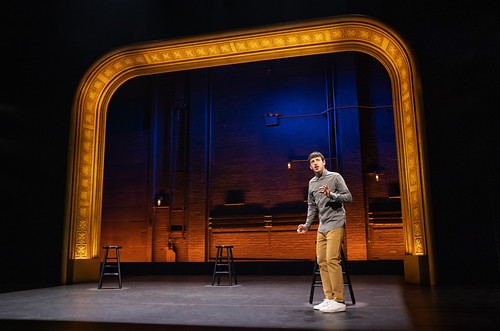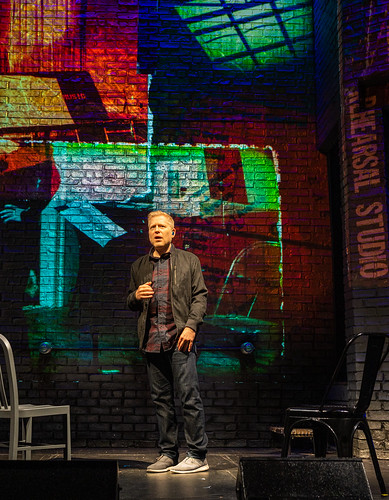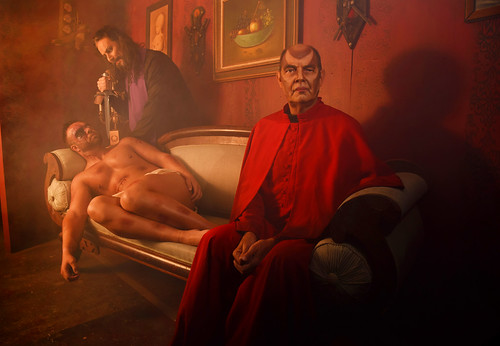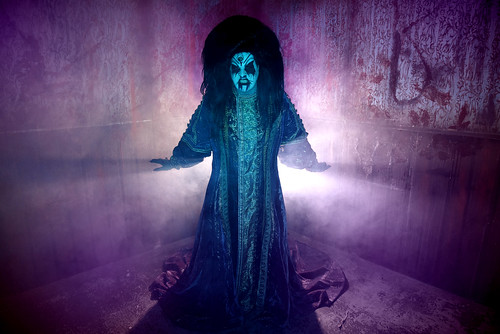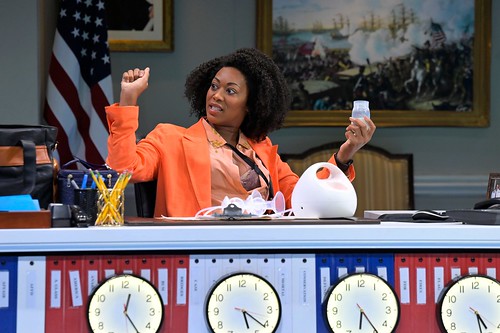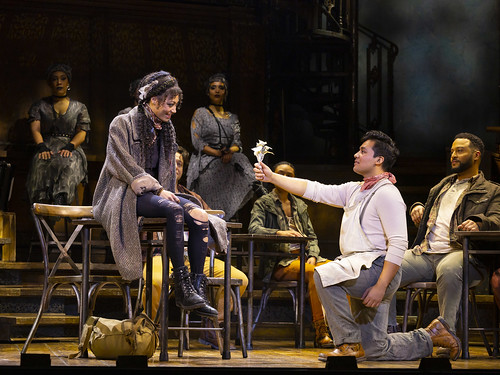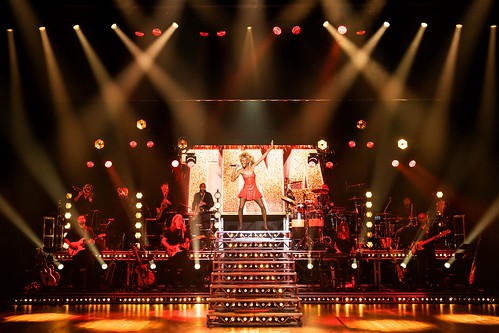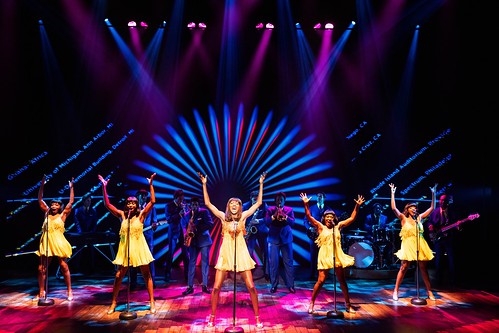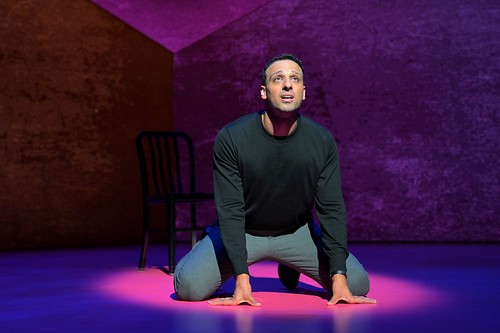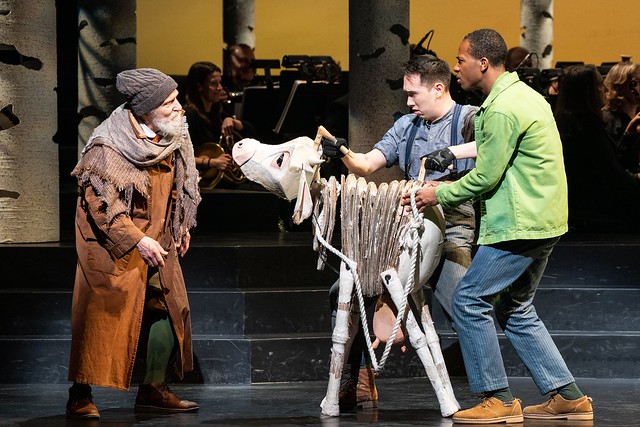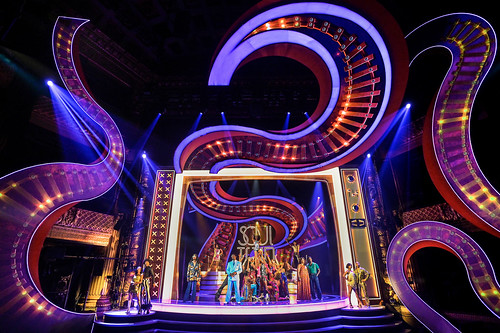
ABOVE: The cast of Hippest Trip – The Soul Train Musical dances up a storm on stage at American Conservatory Theater’s Toni Rembe Theater through Oct. 8. Set design is by Jason Sherwood, projection design is by Aaron Rhyne and lighting is by Jen Schriever. BELOW: Amber Iman is Pam Brown and Quentin Earl Darrington is Don Cornelius. Photos by Kevin Berne & Alessandra Mello
For more than three decades, “Soul Train” was the “hippest trip” on TV. Soul, R&B, funk, disco and hip-hop music combined with the latest dance moves from young Black Americans fused into one of the longest-running syndicated programs in television history. And now “Soul Train,” perhaps inevitably in our jukebox world, is the hippest trip in musical theater.
Hippest Trip – The Soul Train Musical had its world premiere Wednesday and kicked off the new American Conservatory Theater on stage at the Toni Rembe Theater. Clearly this is a show with Broadway in its sights, and the news on that front is mostly good. Hippest Trip explodes with energy and joy. The score contains about 30 songs (mostly snippets) from the “Soul Train” era, which ran from 1971 to 2006. Orchestrated and arranged by Kenny Seymour and played by a sizzling hot 12-piece band (under the music direction of Sean Kana), the song selections feel more appropriate here than they do in a lot of other jukebox musicals.
Many of the songs underscore ferociously entertaining dance numbers choreographed by Camille A. Brown (who is not afraid to get out the rollerskates), and that’s when this show is at its dazzling best. If The Hippest Trip was just this extraordinary ensemble dancing singing through the evolution of ’70s, ’80s and ’90s music the way TV audiences experienced it on “Soul Train,” the show would still be a blast.
But book writer Dominique Morisseau and director Kamilah Forbes have more on their minds than just a nostalgic trip through song and dance. Their focus is “Soul Train” creator Don Cornelius, who went from being a low-level Chicago TV journalist to the master of the “Soul Train” empire. The first act chronicles Cornelius’ struggle to get something on the air to represent Black America beyond the death and devastation that seemed to be filling screens in the early ’70s. Modeled after Dick Clark’s “American Bandstand,” “Soul Train” quickly became a hit in Chicago, so Cornelius moved operations to Los Angeles and took his show into national syndication.
By the end of Act 1, we’re getting into more typical show biz bio territory, with success and ego threatening to overwhelm Cornelius’ integrity (he’d feed his dancers, but he wouldn’t pay them) and taking a toll on his wife and two sons, who remained in Chicago.
While the show pays attention to some of the star “Soul Train” dancers and the artists who spun their time with the show into full careers – Damita Jo Freeman, Jody Watley and Rosie Perez among them – Cornelius remains at the center. Act 2 documents his troubled family life, serious medical issues and his reluctance to share his empire with his son, Tony.

Scenes are fast and the pace is brisk in this 2 1/2-hour spectacle, but Morisseau, a noted playwright who also shaped Ain’t Too Proud – The Life and Times of the Temptations, manages to convey the weight of success and the toll it takes on a person even while fully representing the joy that Cornelius was so intent on documenting and sharing with the world.
Director Forbes revels in the fun of youth and the excitement of being on TV. She is ably assisted by the set (by Jason Sherwood), which turns the proscenium into an old-fashioned TV set and then sends those billowing steamy curls from the “Soul Train” locomotive into the theater in the form of wonderfully effective projection screens filled with the vibrant designs of Aaron Rhyne. I don’t usually dig projections on stage, but in a show about a classic TV show famous for replicating a dance club, the projections are perfect and seriously bolster the general feeling of elation that so often permeates the theater.
And here’s where we get into what might be addressed before heading to Broadway. To be clear, The Hippest Trip is a thoroughly entertaining experience full of sparkle and dazzle (just try to contain the exultation of costumer Dede Ayite’s creations). The parade of song, dance and fashion, combined with clips from the actual show, is simply splendid. And while Cornelius’ creation is justly celebrated and lionized, his life story feels fairly ordinary by show biz bio standards, so Morisseau pushes harder than she needs to convey a looming sense of his faults and the pressures he was under – as Cornelius says frequently, “You can let other people underestimate you, but you never underestimate yourself.” He was fighting to change the world but grew into a cranky old man who didn’t like disco or hip-hop and thought dancers with wild new moves were “weirdos.”
In the end, as much as I admired Cornelius, I found myself more interested in the dancers and the life of the “Soul Train” show itself. I kept wanting this Trip to erupt into a full-blown “Soul Train” dance party – and it felt like the opening-night audience, which happened to be one of the best-dressed audiences I’ve ever seen, wanted that, too. But it doesn’t really happen, even when the full-bore joy returns at the end.
Too many numbers are cut off or interrupted by dialogue. When the great Amber Iman, who plays Pam Brown, Cornelius’ most trusted associate, is singing a soulful song from 1990 (producers have asked we not divulge certain song titles to prevent spoilers), you do not interrupt her. The audience finally gets to let loose with their bottled-up hysteria after a New Jack Swing explosion of “My Prerogative” (that title we can share). But there should be many more ovations before that – the audience wants to pour love into this show and doesn’t get enough opportunity to do so.
What’s not to adore about this mighty, mighty cast? I’ve already noted that the ensemble is overflowing with talent, which is probably why their slice of the show (and a generous slice it is) packs such a wallop. Iman, who starred in the title role of Berkeley Repertory Theatre’s Goddess, is a forthright stunner in an underwritten role. Quentin Earl Darrington as Cornelius gives us a human-scale impresario, a man who wants to be The Wiz but is really just the flawed, hard-working guy behind the curtain. Darrington has a beautiful voice that he gets to show off in the Al Green song “I’m So Tired of Being Alone” and then in a duet with Sidney Dupont, who plays Tony Cornelius. In smaller roles, Kayla Davion, Rich James, Cameron Hah, Jaquez, Mayte Natalio, Alain “Hurrikane” Lauture and Charlene “Chi-Chi” Smith are marvelous as some of the breakout “Soul Train” stars.
As with most jukebox musicals, pop songs that were never intended to bear the weight of musical theater storytelling are nevertheless asked to do so. There’s less of that here because so much of the music is for dancing, and when the pop songs become character songs, there’s a higher success rate than usual. Still, when an optimistic mid-tempo 1970 tune becomes an emotionally fraught duet, the cringe factor is only relieved by the stellar performances.
While there’s still polishing that needs to happen, The Hippest Trip – The Soul Train Musical barrels down the tracks with style, spirt and, as we might expect, abundant love, peace and soul.
FOR MORE INFORMATION
Hippest Trip – The Soul Train Musical continues through Oct. 8 at American Conservatory Theater’s Toni Rembe Theater, 415 Geary St., San Francisco. Running time: 2 hours and 35 minutes (including intermission). Tickets are $25-$140 (subject to change). Call 415-749-2228 or visit act-sf.org.


